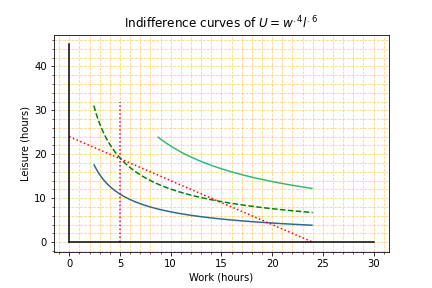Convex-constrained optimization with inequality constraints
Introduction to Optimization in Python

Jasmin Ludolf
Content Developer
Corner versus interior solution
- Alexia only has 5 hours worth of work
$$ w\leq 5$$
- Two constraints:
- 24 hours in a day
- 5 hours of work
- The constraints form a corner
- Interior solution is not an intersection

Manufacturer with capacity constraints
- Automaker produces identical cars in two plants $A$, $B$
- Quantities: $q_A$, $q_B$
- Capacity: $q_A\leq 90$, $q_B\leq 90$
- Cost: $C_A(q)=3q$, $C_B(q)=3.5q$
- Demand:
- $P=120-Q$
- Contract:
- $Q\geq 92$
- Objective to maximize profit:
- $\displaystyle\max \Pi(q_A,q_B)$

Maximizing profit
- Objective:
- $\Pi = R-C$
- $R = PQ$
- $\Pi = R-C$
Maximizing profit
- Objective:
- $\Pi = R-C$
- $R = PQ = (120-Q)Q $
- $\Pi = R-C$
Maximizing profit
Objective:
- $\Pi = R-C$
- $R = PQ = (120-Q)Q=\left[120-(q_A+q_B)\right](q_A+q_B)$
- $C=C_A+C_B=3q_A+3.5q_B$
- $\Pi = R-C$
Bounds
- $0\leq q_A, q_B\leq 90$
- Constraints
- $Q\geq92\Leftrightarrow 92\leq q_A+q_B$
Formulation
$$\max_{q_A,q_B}R(q_A,q_B)-C(q_A,q_B)$$
$$s.t.$$
$$R(q_A,q_B)=\left[120-(q_A+q_B)\right](q_A+q_B)$$
$$\ \ \ \ \ C(q_A,q_B)=3q_A+3.5q_B$$
$$\ \ \ 0\leq q_A, q_B\leq 90$$
$$ \ \ \ \ 92\leq q_A+q_B$$
from scipy.optimize import minimize,\ Bounds, LinearConstraintdef R(q): return (120 - (q[0] + q[1] )) * (q[0] + q[1])def C(q): return 3*q[0] + 3.5*q[1]def profit(q): return R(q) - C(q)bounds = Bounds([0, 0], [90, 90])constraints = LinearConstraint([1, 1], lb=92)
Maximize profit with SciPy
result = minimize(lambda q: -profit(q),[50, 50],bounds=bounds, constraints=constraints)print(result.message) print(f'The optimal number of cars produced in plant A is: {result.x[0]:.2f}') print(f'The optimal number of cars produced in plant B is: {result.x[1]:.2f}') print(f'The firm made: ${-result.fun:.2f}')
Optimization terminated successfully
The optimal number of cars produced in plant A is: 90.00
The optimal number of cars produced in plant B is: 2.00
The firm made: $2299.00
Non-linear contraints in SciPy
from scipy.optimize import NonlinearConstraint import numpy as npconstraints = NonlinearConstraint(lambda q: q[0] + q[1], lb=92, ub=np.inf)result = minimize(lambda q: -profit(q), [50, 50], bounds=Bounds([0, 0], [90, 90]), constraints=constraints)
Solution with NonlinearConstraint
print(result.message)
print(f'The optimal number of cars produced in plant A is: {result.x[0]:.2f}')
print(f'The optimal number of cars produced in plant B is: {result.x[1]:.2f}')
print(f'The firm made: ${-result.fun:.2f}')
Optimization terminated successfully
The optimal number of cars produced in plant A is: 90.00
The optimal number of cars produced in plant B is: 2.00
The firm made: $2299.00
- Use
LinearConstraint()for straightforward, linear problems - Otherwise, use
NonlinearConstraint()
Let's practice!
Introduction to Optimization in Python

